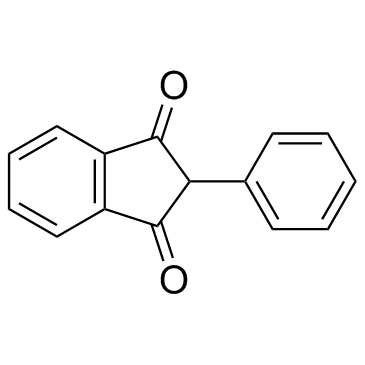Phenindione

Phenindione structure
|
Common Name | Phenindione | ||
|---|---|---|---|---|
| CAS Number | 83-12-5 | Molecular Weight | 222.23900 | |
| Density | 1.343g/cm3 | Boiling Point | 243.3 °C (0.3 mmHg) | |
| Molecular Formula | C15H10O2 | Melting Point | 144-148 °C(lit.) | |
| MSDS | Chinese USA | Flash Point | 208 °C | |
| Symbol |

GHS06 |
Signal Word | Danger | |
|
Multi-target spectral moment QSAR versus ANN for antiparasitic drugs against different parasite species.
Bioorg. Med. Chem. 18 , 2225-31, (2010) There are many of pathogen parasite species with different susceptibility profile to antiparasitic drugs. Unfortunately, almost QSAR models predict the biological activity of drugs against only one parasite species. Consequently, predicting the probability wi... |
|
|
Development of a phospholipidosis database and predictive quantitative structure-activity relationship (QSAR) models.
Toxicol. Mech. Methods 18 , 217-27, (2008) ABSTRACT Drug-induced phospholipidosis (PL) is a condition characterized by the accumulation of phospholipids and drug in lysosomes, and is found in a variety of tissue types. PL is frequently manifested in preclinical studies and may delay or prevent the dev... |
|
|
Maintenance of anticoagulant and antiplatelet agents for patients undergoing peribulbar anesthesia and vitreoretinal surgery.
Retina (Philadelphia, Pa.) 32(9) , 1868-73, (2012) To establish the prevalence of anticoagulation (vitamin K antagonists) and antiplatelet agent therapy in patients undergoing vitreoretinal surgery and to compare the outcome of peribulbar anesthesia and vitreoretinal surgery between users and nonusers.We cond... |
|
|
The effect of cooking on diphacinone residues related to human consumption of feral pig tissues.
Food Chem. Toxicol. 49(9) , 2030-4, (2011) We examined feral pig tissues to determine whether the potential hazard of consuming meat from pigs previously exposed to diphacinone rodenticide baits was reduced by cooking. Residue levels were measured in cooked and uncooked tissues of feral pigs exposed t... |
|
|
An enhancement of europium-/gadolinium- diphacinone -DL-histidine- cetylpyridine bromide system for the determination of diphacinone in serum.
J. Fluoresc. 21(4) , 1349-56, (2011) As one of the first generation anticoagulant rodenticide, diphacinone (DPN) was extensively used in China, and often occurred accidental and intentional intoxications. To meet the needs of clinical emergency rescue, a simple, rapid and sensitive method was ne... |
|
|
Congenital combined deficiency of factor VII and X in a patient due to accidental diphacinone intoxication.
Thromb. Haemost. 106(1) , 180-1, (2011)
|
|
|
[Study on the enhancement diphacinone-europium fluorescence system and application for determination of the residue in urine].
Wei Sheng Yan Jiu 40(4) , 523-6, (2011) To establish an accurate, convenient and sensitive quantitative fluorescence method for the determination of diphacinone (DPN) in urine.Diphacinone was complexed with europium ion (Eu3+) at the presence of DL-histidine, polyvinylpyrrolidone (PVP) and ammonia-... |
|
|
Acute toxicity, histopathology, and coagulopathy in American kestrels (Falco sparverius) following administration of the rodenticide diphacinone.
Environ. Toxicol. Chem. 30(5) , 1213-22, (2011) The acute oral toxicity of the anticoagulant rodenticide diphacinone was found to be over 20 times greater in American kestrels (Falco sparverius; median lethal dose 96.8 mg/kg body weight) compared with Northern bobwhite (Colinus virginianus) and mallards (A... |
|
|
Assessment of toxicity and potential risk of the anticoagulant rodenticide diphacinone using Eastern screech-owls (Megascops asio).
Ecotoxicology 21(3) , 832-46, (2012) In the United States, new regulatory restrictions have been placed on the use of some second-generation anticoagulant rodenticides. This action may be offset by expanded use of first-generation compounds (e.g., diphacinone; DPN). Single-day acute oral exposur... |
|
|
Choose warfarin.
Prescrire Int. 22(139) , 158, (2013)
|